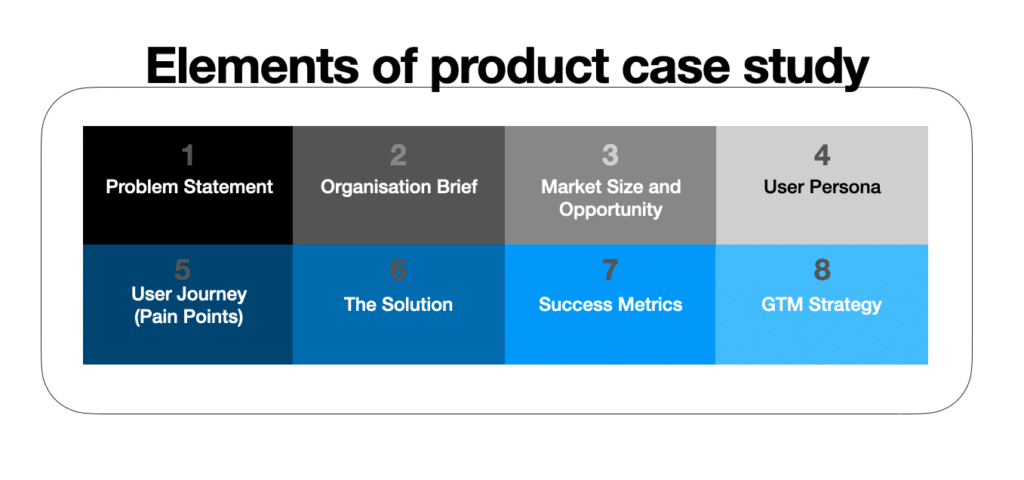
PRODUCT CASE STUDY – ELEMENTS
“Product management is the process of balancing user needs with business goals and technical feasibility.”
– Ellen Gottesdiener
Welcome to Day 26 of the PM series – Product Management in 30 Days!
In the dynamic landscape of product management, one of the most powerful tools at your disposal is the product case study. It’s a comprehensive narrative that takes you on a journey from problem identification to solution implementation. In this detailed post, let us explore the intricacies of developing a product case study, breaking down its core elements, and showcasing how it provides a structured approach to problem-solving. The following post will have examples based on this post. I recommend going through this post first.
Learning Objectives:
- Purpose of Product Case Studies: Understand the pivotal role of product case studies in product management. Recognize how case studies guide through problem identification to solution implementation.
- Essential Elements of a Product Case Study: Identify the critical components: problem statement, company information, market analysis, user persona, and user journey. Comprehend the importance of prioritization, prototypes, success metrics, and go-to-market strategy.
- Crafting a Compelling Problem Statement: Learn to create a concise and impactful problem statement with specificity, user pain points, and a natural transition to the proposed solution.
- Market Analysis, Product Development and GTM: Understand the process of examining market size, defining target markets, and presenting growth prospects. Understand how to introduce the solution by prioritizing features, showcasing prototypes, and detailing results from user testing. Recognize the importance of defining success metrics and discussing a comprehensive go-to-market strategy.
Why product case study?
- Problem-Solving Showcase: Product case studies provide a platform to showcase how a product addresses specific problems, demonstrating the effectiveness of problem-solving strategies.
- Narrative of Product Development: They offer a comprehensive narrative, guiding the audience through the entire product development journey from problem identification to solution implementation.
- Communication and Learning Tool: Product Case studies serve as effective communication tools, aiding in conveying complex product management concepts and strategies. They also serve as valuable learning resources for professionals and aspiring product managers.
- Illustration of Strategic Thinking: By breaking down the core elements of a product, case studies illustrate strategic thinking, decision-making processes, and the rationale behind prioritizing features and solutions.
- Measurement of Success and Impact: Product case studies define success metrics, providing a structured approach to measuring the impact of a product. They offer insights into the effectiveness of the solution and its alignment with user needs and business goals.
Eight key elements of a product case study:

1️⃣ The Foundation: Problem Statement
A product case study begins with a clear problem statement. This sets the stage for everything that follows. It should define the issue, its impact, and the pain points it causes. Include data and insights that highlight the urgency and significance of the problem.
Creating a compelling problem statement is crucial for framing a product case study effectively. Here are seven tips along with an example:
- Clearly Define the Problem: Be specific and concise in articulating the problem your product addresses.
Example: “Many commuters in urban areas struggle with unpredictable traffic congestion, leading to delayed arrivals and increased stress levels.”
- Highlight the Impact: Emphasize the significance of the problem to convey its importance.
Example: “The inefficiencies in current traffic management systems not only result in wasted time for commuters but also contribute to environmental pollution due to prolonged idling.”
- Identify the Target Audience: Specify who experiences the problem to create a focused problem statement.
Example: “Our target audience, daily urban commuters, faces challenges in navigating congested traffic and desires a solution that enhances their overall commuting experience.”
- Quantify if Possible: Use data or statistics to quantify the problem’s magnitude whenever feasible.
Example: “On average, commuters spend an extra 30 minutes daily in traffic, leading to a cumulative loss of over 150 hours per year per individual.”
- Connect to User Pain Points: Relate the problem to the pain points and frustrations of the target audience.
Example: “The current traffic conditions not only waste valuable time but also contribute to increased stress levels and decreased overall well-being for commuters.”
- Highlight Existing Solutions and Their Limitations: Acknowledge any existing solutions and their shortcomings to justify the need for your product.
Example: “While navigation apps provide route suggestions, they lack real-time adaptability and fail to address the root causes of traffic congestion.”
- Set the Stage for a Solution: Craft the problem statement in a way that naturally leads to the introduction of your product as a viable solution.
Example: “Our product aims to revolutionize the commuting experience by providing a dynamic, real-time traffic management solution that not only optimizes routes but also addresses the underlying causes of congestion.”
Remember, a well-crafted problem statement sets the foundation for your product case study, helping readers understand the context, significance, and motivation behind the development of your product.
2️⃣ Relevant Company Information
To understand the context of the problem, provide a brief overview of the company, its mission, and its current product portfolio. This helps the reader see where the product case study fits into the larger picture.
Highlight the company’s strengths and any previous successes. For instance, if it’s a health tech startup, mention its mission to revolutionize healthcare through technology and its previous successful product launches.
Include Key Statistics and Achievements: Showcase relevant statistics, achievements, and milestones to build credibility.
Provide Insight into Market Position and Competition: Offer insights into the company’s market position and acknowledge competition to demonstrate awareness.
3️⃣ Market Size and Opportunity
Next, examine the market size and the opportunity your product seeks to tap into. Quantify the potential, define the target market, and outline the growth prospects.
Back this information with market research and competitive analysis to underscore the viability of the opportunity. If you’re working on a new e-commerce app, provide statistics on the e-commerce industry’s growth and the increasing consumer shift to online shopping.
For more insights on Market Sizing, you may read this post – Market Sizing for Beginners
4️⃣ User Persona
A key element of the product case study is the user persona. Describe the ideal customer—their characteristics, needs, goals, and pain points. Creating a relatable user persona helps the reader empathize with the problem. Include interviews or surveys that helped shape this persona and establish its authenticity. In the context of a travel tech startup, the user persona might be a tech-savvy millennial traveller who values unique, local experiences.
We have learned this on our product management journey on Day 08! You might want to revisit it. Here is the link – User persona
5️⃣ User Journey
The user journey maps out how the user interacts with the product or service. It defines the steps they take, the touchpoints they encounter, and the emotions they experience throughout the process. Provide visuals and scenarios to make the user journey come to life. The user journey could be both happy and unhappy.
Again, we have learned this on Day 09 – User Journey
Pain Points
Detail the pain points experienced by the user. These could be challenges, inconveniences, or unmet needs. This part of the case study crystallizes the user’s frustrations. Include real quotes or anecdotes from users that highlight these pain points. For instance, if you’re developing a food delivery app, you can quote users complaining about late deliveries, incorrect orders, or limited restaurant choices.
6️⃣ The Solution: Prioritization and Prototypes
Now, introduce the solution. Prioritize features based on user needs, business goals, and technical feasibility. Explain how you selected the features for development. Discuss any trade-offs or compromises made during this process. Additionally, it details the results of any user testing that informed feature prioritization.
Provide a detailed glimpse of the prototypes or mock-ups created during the ideation phase. Visuals help the reader understand how the solution addresses the problem. Include feedback from user testing and iterations made based on this feedback. In the context of a productivity app, showcase the prototype’s evolution, emphasizing how user feedback shaped its design.
For more details, revisit
- Day 10 – Prototypes
- Day12 – Agile Development
7️⃣ Success Metrics
Define the success metrics that will be used to measure the effectiveness of the solution. Whether it’s user engagement, conversion rates, or customer satisfaction, these metrics should be clearly established. Create a timeline for tracking these metrics post-launch and include benchmarks for comparison. For a fitness app, success metrics might include daily active users, workout completion rates, and user reviews.
For more details, revisit Day15 – Product Analytics
8️⃣ Go-To-Market Strategy
Discuss the go-to-market (GTM) strategy in depth. How will the product be launched? What channels will be used for distribution, and what is the marketing plan? The GTM strategy is crucial for a successful product launch. Include a detailed launch timeline with key milestones, as well as results from beta testing and soft launches.
For more details, revisit Day16 – GTM Strategy
Conclusion: Power in Structure
Developing a product case study isn’t just about storytelling; it’s about problem-solving and structure. It provides a systematic approach to addressing issues, creating solutions, and measuring success. In an ever-evolving product management landscape, mastering the art of the product case study is an indispensable skill.
As you chart your own path in product management, remember that a well-structured product case study can serve as a powerful tool for communication, problem-solving, and success measurement.
Quiz Time:
Question: What is the primary purpose of a product case study?
A. Marketing promotion
B. Showcase of problem-solving
C. Historical documentation
D. Financial analysis
Question: Which of the following is not an essential element of a product case study?
A. User Persona
B. Market Size
C. Employee Testimonials
D. Success Metrics
Question: Why is crafting a compelling problem statement crucial in a product case study?
A. To confuse the audience
B. To set the stage for a solution
C. To hide the problem
D. To skip user persona development
Question: What does a user journey in a product case study map out?
A. Financial projections
B. User interactions and emotional experiences
C. Employee satisfaction
D. Market competition
Question: What is the significance of success metrics in a product case study?
A. To confuse the audience
B. To measure the impact of the solution
C. To hide the problem
D. To skip user persona development
✍️ Write your answers in the comment section. e.g 1-a, 2-b, 3-c etc.
If you arrived at this post via some link and want to learn more about product management, you can also find other posts. The Full series is available here
One of the recommended books to learn about product management is How to Lead in Product Management by Roman Pichler
💌 Do drop me a comment below if you found the content useful and/or want me to write on a specific topic. This will make my day! 🙂
Also, share the post if you think this might help someone. The sharing link is at the top of the page.
Join FreeMentor as a student if you are a newbie in product management and want to have one Free 1:1 mentorship session.
#ProductManagement #CaseStudy #ProblemSolving #UserPersona #GoToMarket #Airbnb #LinkedInLearning 🚀

